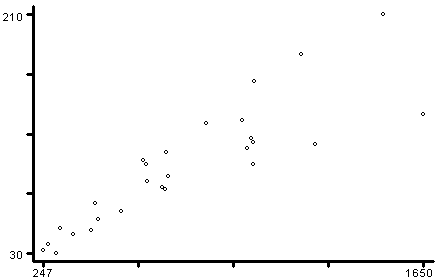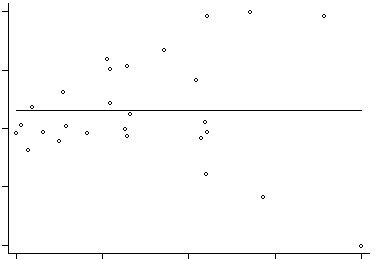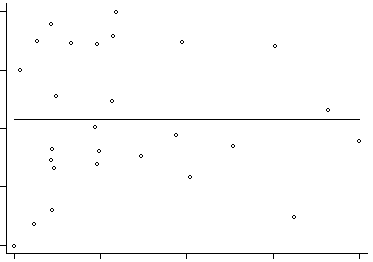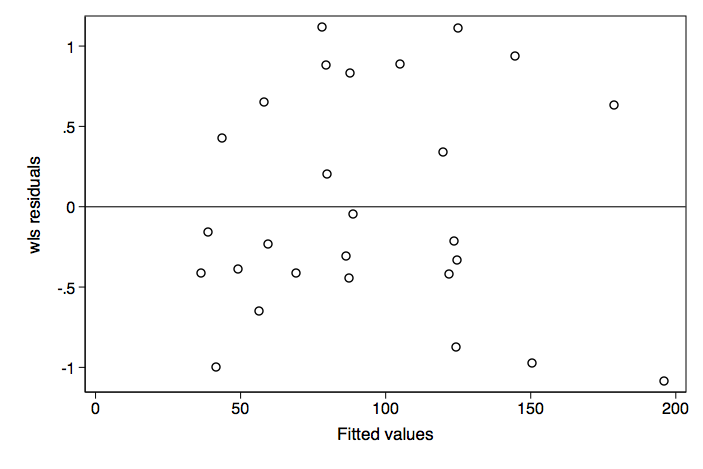
Ordinary least squares (OLS) is the type of regression estimation that we have covered so far in class. OLS, while generally robust, can produce unacceptably high standard errors when the homogeneity of variance assumption is violated. Weighted least squares (WLS) encompases various schemes for weighting observations in order to reduce the effects of heteroscedasticity.
In WLS the goal is to minimize to following sum of squares:

The trick, of course, is determining the values for wi. According to Miller (1986), "If God or the Devil were willing to tell us the values of wi...", then the task would be easy.
A Simple Example
From Chatterjee & Price (1977) a study of 27 industrial companies of varying size, recorded the number of workers (x) and the number of supervisors (y). The model y = bo + b1x + e was examined.
OLS Analysis
use http://www.philender.com/courses/data/wls, clear scatter y x, msym(oh)

regress y x
Source | SS df MS Number of obs = 27
---------+------------------------------ F( 1, 25) = 86.54
Model | 40862.6027 1 40862.6027 Prob > F = 0.0000
Residual | 11804.064 25 472.16256 R-squared = 0.7759
---------+------------------------------ Adj R-squared = 0.7669
Total | 52666.6667 26 2025.64103 Root MSE = 21.729
------------------------------------------------------------------------------
y | Coef. Std. Err. t P>|t| [95% Conf. Interval]
---------+--------------------------------------------------------------------
x | .1053611 .0113256 9.303 0.000 .0820355 .1286867
_cons | 14.44806 9.562012 1.511 0.143 -5.245273 34.14139
------------------------------------------------------------------------------
rvfplot, yline(0)

Remarks
WLS Analysis
generate yt = y/x
generate xt = 1/x
regress yt xt
Source | SS df MS Number of obs = 27
---------+------------------------------ F( 1, 25) = 0.69
Model | .000355828 1 .000355828 Prob > F = 0.4131
Residual | .012842316 25 .000513693 R-squared = 0.0270
---------+------------------------------ Adj R-squared = -0.0120
Total | .013198144 26 .000507621 Root MSE = .02266
------------------------------------------------------------------------------
yt | Coef. Std. Err. t P>|t| [95% Conf. Interval]
---------+--------------------------------------------------------------------
xt | 3.803296 4.569745 0.832 0.413 -5.60827 13.21486
_cons | .1209903 .0089986 13.445 0.000 .1024573 .1395233
------------------------------------------------------------------------------Remarks
(x)yt = (x)bo + (x)b1xt [multiply by x]
(x)y/x = (x)bo + 1/x [substitute for transformed variables]
y = (x)bo + b1 [which can be rewritten]
y = b1x + b0 = 0.12x + 3.80
generate p1 = 3.803296 + .1209903*x
corr p1 y
(obs=27)
| p1 y
-------------+------------------
p1 | 1.0000
y | 0.8808 1.0000
rvfplot, yline(0)

Remarks
Inspection of the residual vs fitted (predicted) plot shows improvement in terms of heteroscedasticity.
WLS the Easy Way
Stata allows us to do WLS through the use of analytic weights, which can be included as part of the regress command.
regress y x [aw = 1/x^2]
(sum of wgt is 1.0470e-004)
Source | SS df MS Number of obs = 27
---------+------------------------------ F( 1, 25) = 180.78
Model | 23948.6837 1 23948.6837 Prob > F = 0.0000
Residual | 3311.87511 25 132.475004 R-squared = 0.8785
---------+------------------------------ Adj R-squared = 0.8737
Total | 27260.5588 26 1048.48303 Root MSE = 11.51
------------------------------------------------------------------------------
y | Coef. Std. Err. t P>|t| [95% Conf. Interval]
---------+--------------------------------------------------------------------
x | .1209903 .0089986 13.445 0.000 .1024573 .1395233
_cons | 3.803296 4.569745 0.832 0.413 -5.608271 13.21486
------------------------------------------------------------------------------
The results obtained are the same as going through the process of transforming each of the variables.
More About WLS
There are many other possible weighting schemes:
Weighted Least Squares using wls0
With wls0 you can use any of the following weighting schemes: 1) abse - absolute value of residual, 2) e2 - residual squared, 3) loge2 - log residual squared, and 4) xb2 - fitted value squared. We will demonstrate the command with the loge2 option.
wls0 y x, wvar(x) type(loge2) graph
WLS regression - type: proportional to log(e)^2
(sum of wgt is 1.3388e+00)
Source | SS df MS Number of obs = 27
-------------+------------------------------ F( 1, 25) = 128.32
Model | 36182.5945 1 36182.5945 Prob > F = 0.0000
Residual | 7049.36879 25 281.974752 R-squared = 0.8369
-------------+------------------------------ Adj R-squared = 0.8304
Total | 43231.9632 26 1662.76782 Root MSE = 16.792
------------------------------------------------------------------------------
y | Coef. Std. Err. t P>|t| [95% Conf. Interval]
-------------+----------------------------------------------------------------
x | .113653 .0100331 11.33 0.000 .0929894 .1343166
_cons | 8.461635 6.925202 1.22 0.233 -5.801086 22.72436
------------------------------------------------------------------------------
